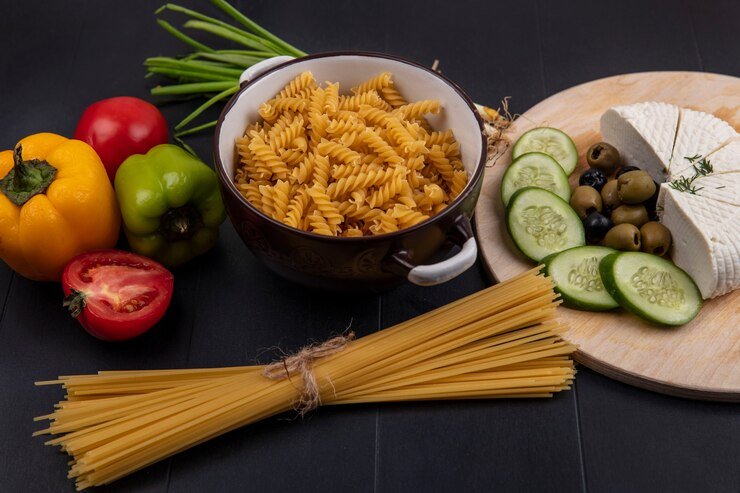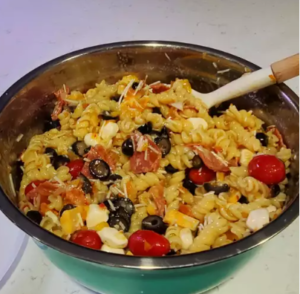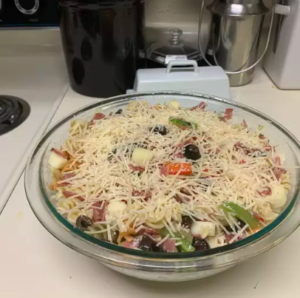Step-by-Step Recipe
Creating a delightful pasta salad requires a bit more than just tossing ingredients together. Here’s a step-by-step guide to ensure that your salad is as flavorful as it is visually appealing.
-
Cook the Pasta:
Start by bringing a large pot of salted water to a boil. Add your chosen pasta and cook it until al dente, usually about 8-10 minutes, depending on the type. Drain and rinse under cold water to stop the cooking process and remove excess starch. This step is crucial as it helps the pasta maintain its firm texture and prevents it from absorbing too much dressing.
-
Prepare the Vegetables:
While the pasta cooks, prepare your vegetables. Wash and chop your chosen veggies into bite-sized pieces. If using harder vegetables like carrots or broccoli, consider blanching them briefly in boiling water to soften them slightly without losing their crunch.
-
Mix the Dressing:
In a large mixing bowl, combine your dressing ingredients. Whether you’re going for a zesty vinaigrette or a creamy mayonnaise base, whisk them together until smooth. This is also a great time to add any special ingredients like fresh herbs, capers, or a splash of lemon juice for extra zest.
-
Combine Ingredients:
Add the cooled pasta to your dressing in the bowl. Toss well to ensure each piece is evenly coated. Then, gradually mix in your vegetables, proteins (if using), and any other add-ins like olives or cheese. Toss gently but thoroughly to distribute all the flavors.
-
Refrigerate Before Serving:
For the best results, cover your salad and let it chill in the refrigerator for at least 30 minutes before serving. This resting period allows the flavors to meld together beautifully, enhancing the overall taste of your pasta salad.
-
Final Touches:
Before serving, give the salad a good stir and taste it. Adjust the seasoning with more salt, pepper, or dressing if needed. Garnish with a sprinkle of fresh herbs or a few extra toppings for color and texture.
This method ensures that every element of your pasta salad shines through, from the perfectly cooked pasta to the crisp vegetables and flavorful dressing. By following these steps, you’re well on your way to creating a crowd-pleaser that’s both nutritious and satisfying. For additional ideas and variations on pasta salads, check out Serious Eats for their creative takes and advanced culinary tips.
Customization and Variations
The joy of making pasta salad lies in its adaptability. With a few tweaks, you can customize your salad to match any theme, taste preference, or dietary requirement. Let’s explore some creative ways to personalize your dish.
By Cuisine
Theming your pasta salad around different cuisines is a fantastic way to bring new flavors to your table. For an Italian-inspired salad, incorporate ingredients like sundried tomatoes, fresh basil, and mozzarella balls drizzled with a balsamic glaze. For a Greek twist, mix in feta cheese, kalamata olives, and cucumbers with a lemon-oregano dressing. If you’re leaning towards an American BBQ style, consider adding smoked turkey, crispy bacon, and a creamy ranch dressing.
Dietary Adjustments
Pasta salad is incredibly forgiving when it comes to making dietary adjustments. For a gluten-free version, simply use gluten-free pasta available in most supermarkets. Vegetarians can enjoy a hearty salad by skipping meats and adding more beans and cheeses like chickpeas and goat cheese for protein. For a vegan salad, omit all animal products and include vegan cheese and protein-rich legumes, like lentils or black beans. Adding these elements ensures that everyone at your table can enjoy a delicious, satisfying meal.
These variations not only add a delightful twist to the traditional pasta salad but also cater to the diverse tastes and dietary needs of your guests or family. Experiment with different ingredients and dressings to discover new favorite combinations that will keep your pasta salads exciting and new.



